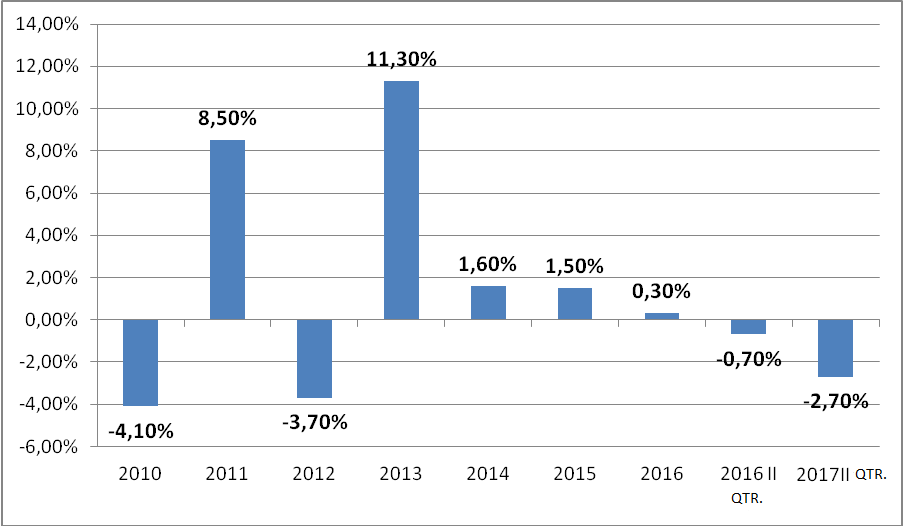European Georgia Movement for Freedom member, Giorgi Kandelaki, talked about the agricultural sector during the discussion of the draft state budget at the Parliament of Georgia and stated: “In 2016, according to the National Statistics Office of Georgia, the agricultural growth rate was 0% whilst we have a decline in 2017. Against this backdrop, you take pride in achievements in the field of agriculture.”
FactCheck took interest in the accuracy of the statement.
A country’s economic growth is measured by changes in real added value. In order to see progress in the agricultural sector, we have to compare real added value in this field to the analogous figure of the previous year. Making a comparison by this method is a way to differentiate from the added value which was a result of price increase.
Graph 1: Agricultural Sector Real Growth Rate in 2010-2017
 As illustrated by the graph, the agricultural growth rate was 0.3% in 2016 and 1.5% in 2015.
In regard to this year, considering the fact that figures for only the first two quarters are currently available, we can compare this result to the analogous figure of 2016. The comparison shows that real production in agricultural dropped by 2.7% in the first half of 2017 (two quarters).
Discussions about the agricultural sector must also include projects which are now in progress as a result of state support for developing the field.
As illustrated by the graph, the highest real growth rate for agriculture (11.30%) was registered in 2013. It was precisely in 2013 when the Preferential Agro Credit project, which envisaged affordable long-term loans for farmers, was launched. Within the framework of this project, 154 new enterprises were established and 700 enterprises were expanded in 2013-2016. Loans with a total volume of USD 197,874,322 and GEL 690,662,461 were issued as a part of the project’s activities in the same period.
Within the framework of the project’s co-funding component, the total amount of co-funding for processing and storage enterprises constituted USD 6,710,445 until 2017.
The Agricultural Insurance project was launched in September 2014. A total of 29,719 insurance policies were opened with the total amount of premiums paid by the insurance agencies reaching GEL 14,658,868.
The Small Farmer Spring Work Assistance programme took place between 2013 and 2016. A total of 827,332 hectares of land was cultivated in this period with the total amount of beneficiary benefit having reached GEL 340,265,800. The programme ended in 2017.
As we can see, despite certain interventions in the agricultural sector on the part of the Government of Georgia dating to 2013, the real agricultural growth rate has had a tendency of decline. In 2017, however, the volume of agriculture (in value form) will decrease.
Conclusion
In 2016, Georgia’s agricultural growth rate was 0.3%. The real added value in agriculture decreased by 2.7% in the first two quarters of 2017.
Even though the Government of Georgia has been carrying out several programmes to support agriculture, it has failed to become a driving force behind economic growth and remains dependent on subsidies.
FactCheck concludes that Giorgi Kandelaki’s statement is TRUE.
As illustrated by the graph, the agricultural growth rate was 0.3% in 2016 and 1.5% in 2015.
In regard to this year, considering the fact that figures for only the first two quarters are currently available, we can compare this result to the analogous figure of 2016. The comparison shows that real production in agricultural dropped by 2.7% in the first half of 2017 (two quarters).
Discussions about the agricultural sector must also include projects which are now in progress as a result of state support for developing the field.
As illustrated by the graph, the highest real growth rate for agriculture (11.30%) was registered in 2013. It was precisely in 2013 when the Preferential Agro Credit project, which envisaged affordable long-term loans for farmers, was launched. Within the framework of this project, 154 new enterprises were established and 700 enterprises were expanded in 2013-2016. Loans with a total volume of USD 197,874,322 and GEL 690,662,461 were issued as a part of the project’s activities in the same period.
Within the framework of the project’s co-funding component, the total amount of co-funding for processing and storage enterprises constituted USD 6,710,445 until 2017.
The Agricultural Insurance project was launched in September 2014. A total of 29,719 insurance policies were opened with the total amount of premiums paid by the insurance agencies reaching GEL 14,658,868.
The Small Farmer Spring Work Assistance programme took place between 2013 and 2016. A total of 827,332 hectares of land was cultivated in this period with the total amount of beneficiary benefit having reached GEL 340,265,800. The programme ended in 2017.
As we can see, despite certain interventions in the agricultural sector on the part of the Government of Georgia dating to 2013, the real agricultural growth rate has had a tendency of decline. In 2017, however, the volume of agriculture (in value form) will decrease.
Conclusion
In 2016, Georgia’s agricultural growth rate was 0.3%. The real added value in agriculture decreased by 2.7% in the first two quarters of 2017.
Even though the Government of Georgia has been carrying out several programmes to support agriculture, it has failed to become a driving force behind economic growth and remains dependent on subsidies.
FactCheck concludes that Giorgi Kandelaki’s statement is TRUE.
 As illustrated by the graph, the agricultural growth rate was 0.3% in 2016 and 1.5% in 2015.
In regard to this year, considering the fact that figures for only the first two quarters are currently available, we can compare this result to the analogous figure of 2016. The comparison shows that real production in agricultural dropped by 2.7% in the first half of 2017 (two quarters).
Discussions about the agricultural sector must also include projects which are now in progress as a result of state support for developing the field.
As illustrated by the graph, the highest real growth rate for agriculture (11.30%) was registered in 2013. It was precisely in 2013 when the Preferential Agro Credit project, which envisaged affordable long-term loans for farmers, was launched. Within the framework of this project, 154 new enterprises were established and 700 enterprises were expanded in 2013-2016. Loans with a total volume of USD 197,874,322 and GEL 690,662,461 were issued as a part of the project’s activities in the same period.
Within the framework of the project’s co-funding component, the total amount of co-funding for processing and storage enterprises constituted USD 6,710,445 until 2017.
The Agricultural Insurance project was launched in September 2014. A total of 29,719 insurance policies were opened with the total amount of premiums paid by the insurance agencies reaching GEL 14,658,868.
The Small Farmer Spring Work Assistance programme took place between 2013 and 2016. A total of 827,332 hectares of land was cultivated in this period with the total amount of beneficiary benefit having reached GEL 340,265,800. The programme ended in 2017.
As we can see, despite certain interventions in the agricultural sector on the part of the Government of Georgia dating to 2013, the real agricultural growth rate has had a tendency of decline. In 2017, however, the volume of agriculture (in value form) will decrease.
Conclusion
In 2016, Georgia’s agricultural growth rate was 0.3%. The real added value in agriculture decreased by 2.7% in the first two quarters of 2017.
Even though the Government of Georgia has been carrying out several programmes to support agriculture, it has failed to become a driving force behind economic growth and remains dependent on subsidies.
FactCheck concludes that Giorgi Kandelaki’s statement is TRUE.
As illustrated by the graph, the agricultural growth rate was 0.3% in 2016 and 1.5% in 2015.
In regard to this year, considering the fact that figures for only the first two quarters are currently available, we can compare this result to the analogous figure of 2016. The comparison shows that real production in agricultural dropped by 2.7% in the first half of 2017 (two quarters).
Discussions about the agricultural sector must also include projects which are now in progress as a result of state support for developing the field.
As illustrated by the graph, the highest real growth rate for agriculture (11.30%) was registered in 2013. It was precisely in 2013 when the Preferential Agro Credit project, which envisaged affordable long-term loans for farmers, was launched. Within the framework of this project, 154 new enterprises were established and 700 enterprises were expanded in 2013-2016. Loans with a total volume of USD 197,874,322 and GEL 690,662,461 were issued as a part of the project’s activities in the same period.
Within the framework of the project’s co-funding component, the total amount of co-funding for processing and storage enterprises constituted USD 6,710,445 until 2017.
The Agricultural Insurance project was launched in September 2014. A total of 29,719 insurance policies were opened with the total amount of premiums paid by the insurance agencies reaching GEL 14,658,868.
The Small Farmer Spring Work Assistance programme took place between 2013 and 2016. A total of 827,332 hectares of land was cultivated in this period with the total amount of beneficiary benefit having reached GEL 340,265,800. The programme ended in 2017.
As we can see, despite certain interventions in the agricultural sector on the part of the Government of Georgia dating to 2013, the real agricultural growth rate has had a tendency of decline. In 2017, however, the volume of agriculture (in value form) will decrease.
Conclusion
In 2016, Georgia’s agricultural growth rate was 0.3%. The real added value in agriculture decreased by 2.7% in the first two quarters of 2017.
Even though the Government of Georgia has been carrying out several programmes to support agriculture, it has failed to become a driving force behind economic growth and remains dependent on subsidies.
FactCheck concludes that Giorgi Kandelaki’s statement is TRUE.
Tags:








